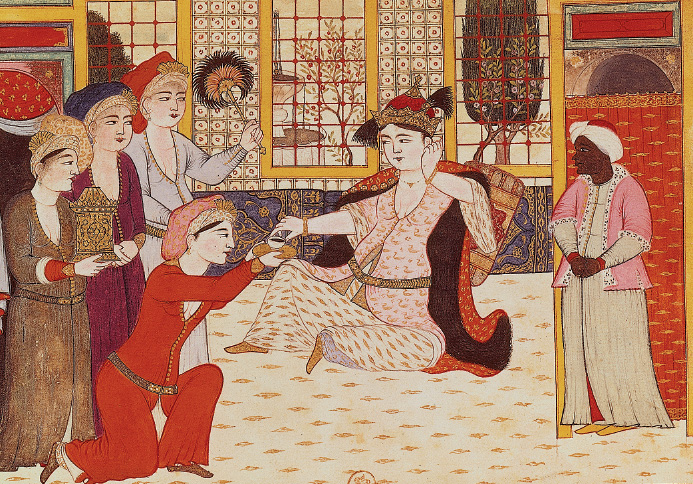A History of Western Society: Printed Page 488
A History of Western Society, Value Edition: Printed Page 504
INDIVIDUALS IN SOCIETY
Hürrem

In Muslim culture, harem means a sacred place or a sanctuary. The term was applied to the part of the household occupied by women and children and forbidden to men outside the family. The most famous harem member in Ottoman history was Hürrem, wife of Suleiman the Magnificent.
Like many of the sultan’s concubines, Hürrem (1505?–1558) was of foreign birth. Tradition holds that she was born Aleksandra Lisowska in the kingdom of Poland (present-day Ukraine). Captured during a Tartar raid and enslaved, she entered the imperial harem between 1517 and 1520, when she was about fifteen years old. Reports from Venetian visitors claimed that she was not outstandingly beautiful, but was possessed of wonderful grace, charm, and good humor, earning her the Turkish nickname Hürrem, or “joyful one.” Soon after her arrival, Hürrem became the imperial favorite.
Suleiman’s love for Hürrem led him to set aside all precedents for the role of a concubine, including the rule that concubines must cease having children once they gave birth to a male heir. By 1531 Hürrem had given Suleiman one daughter and five sons. In 1533 or 1534 Suleiman entered formal marriage with his consort — an unprecedented and scandalous honor for a concubine. Suleiman reportedly lavished attention on his wife and defied convention by allowing her to remain in the palace throughout her life instead of accompanying her son to a provincial governorship.
Contemporaries were shocked by Hürrem’s influence over the sultan and resentful of the apparent role she played in politics and diplomacy. The Venetian ambassador Bassano wrote that “the Janissaries and the entire court hate her and her children likewise, but because the Sultan loves her, no one dares to speak.”* Court rumors circulated that Hürrem used witchcraft to control the sultan and ordered the sultan’s execution of his first-born son by another mother.
The correspondence between Suleiman and Hürrem, unavailable until the nineteenth century, along with Suleiman’s own diaries, confirms her status as the sultan’s most trusted confidant and adviser. During his frequent absences, the pair exchanged passionate love letters. Hürrem included political information and warned of potential uprisings. She also intervened in affairs between the empire and her former home, apparently helping Poland attain its privileged diplomatic status. She brought a feminine touch to diplomatic relations, sending personally embroidered articles to foreign leaders.
Hürrem used her enormous pension to contribute a mosque, two schools, a hospital, a fountain, and two public baths to Istanbul. In Jerusalem, Mecca, and Istanbul, she provided soup kitchens and hospices for pilgrims and the poor. She died in 1558, eight years before her husband. Her son Selim II (r. 1566–1574) inherited the throne.
Relying on Western observers’ reports, historians traditionally depicted Hürrem as a manipulative and power-hungry social climber. They portrayed her career as the beginning of a “sultanate of women” in which strong imperial leadership gave way to court intrigue and debauchery. More recent historians have emphasized the intelligence and courage Hürrem demonstrated in navigating the ruthlessly competitive world of the harem.
Hürrem’s journey from Ukrainian maiden to concubine to sultan’s wife captured enormous public attention. She is the subject of numerous paintings, plays, and novels, as well as an opera, a ballet, and a symphony by the composer Haydn. Interest in and suspicion of Hürrem continues. In 2003 a Turkish miniseries once more depicted her as a scheming intriguer.
Source: Leslie P. Pierce, The Imperial Harem: Women and Sovereignty in the Ottoman Empire (New York: Oxford University Press, 1993).
QUESTIONS FOR ANALYSIS
Question
What types of power did Hürrem exercise during her lifetime? How did her gender enable her to attain certain kinds of power and also constrain her ability to exercise it?
Question
What can an exceptional woman like Hürrem reveal about the broader political and social world in which she lived?
